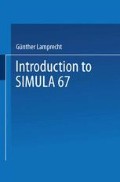Abstract
The previous chapter dealt with the classes as a compound object. We showed how to combine variables of different types to a new unit and how to approach the Individual items of the object. Although we can establish the most complex structures, using comprehensive classes and subclasses, it will become evident that the concept of classes in SIMULA is even more general and extensive.
Access this chapter
Tax calculation will be finalised at checkout
Purchases are for personal use only
Preview
Unable to display preview. Download preview PDF.
Reference
If the class with the name ‘name’ is intended to be a subclass of another class with the name ‘namel’, we must put namel as a prefix in front of the class declaration so that it runs, namel CLASS name(Ifp);
In case the class is a subclass, it may become necessary to extend the list of actual parameters on the left side by those of the comprehensive class(es).
For more details on orthogonal polynoms see, M. Abramowitz and I.A. Stegun, Handbook of Mathematical Functions, Dover Publications, New York, 1965.
This method is likely to give rise to mistakes, which will take trouble (and time) to find. Therefore, you should specify every vector or matrix as a formal parameter by stating VALUE…; in the class head. incarnation is offered by using subclasses in connection with the specification VIRTUAL. This way will be described now.
In addition, it is possible to specify LABEL or SWITCH. As in practice these items are not required, they will not be described here.
One exception is the SIMULA compiler of UNIVAC which includes complex arithmetic.
Author information
Authors and Affiliations
Rights and permissions
Copyright information
© 1981 Springer Fachmedien Wiesbaden
About this chapter
Cite this chapter
Lamprecht, G. (1981). Classes with Statements, Classes as a Program System. In: Introduction to SIMULA 67. Vieweg+Teubner Verlag, Wiesbaden. https://doi.org/10.1007/978-3-663-14077-1_11
Download citation
DOI: https://doi.org/10.1007/978-3-663-14077-1_11
Publisher Name: Vieweg+Teubner Verlag, Wiesbaden
Print ISBN: 978-3-528-03340-8
Online ISBN: 978-3-663-14077-1
eBook Packages: Springer Book Archive

